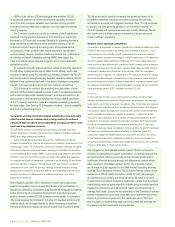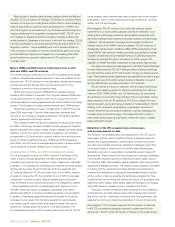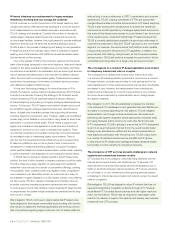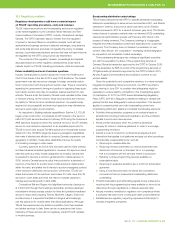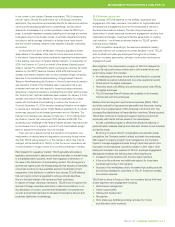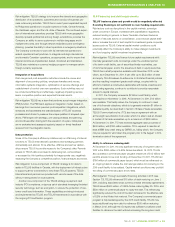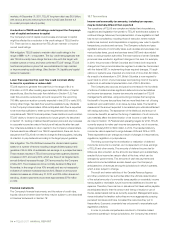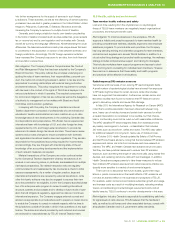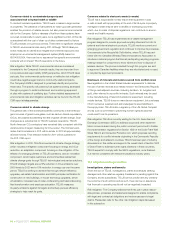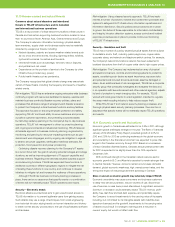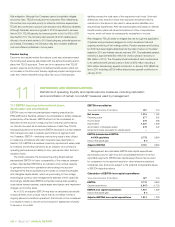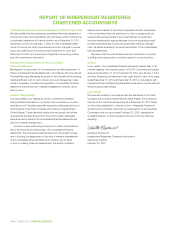Telus 2011 Annual Report Download - page 98
Download and view the complete annual report
Please find page 98 of the 2011 Telus annual report below. You can navigate through the pages in the report by either clicking on the pages listed below, or by using the keyword search tool below to find specific information within the annual report.
94 . TELUS 2011 ANNUAL REPORT
markets. At December 31, 2011, TELUS’ long-term debt was $6.6 bil lion,
with various amounts maturing from 2012 to 2025 (see Section 4.3
for a debt principal maturity profile).
A reduction in TELUS credit ratings could impact the Company’s
cost of capital and access to capital
The Company’s cost of capital could increase and access to capital
might be affected by a reduction in the credit ratings of TELUS and/or
TCI. There can be no assurance that TELUS can maintain or improve
current credit ratings.
Risk mitigation: TELUS seeks to maintain debt credit ratings in the
range of BBB+ to A–, or equivalent. The four credit rating agencies that
rate TELUS currently have ratings that are in line with this target, with
a stable outlook or trend, and have confirmed TELUS’ ratings. TELUS
has financial policies in place that were established to help maintain
or improve existing credit ratings. (See Section 7.4 Liquidity and capital
resource measures.)
Lower than expected free cash flow could constrain ability
to invest in operations or reduce debt
TELUS expects to generate free cash flow in the range of $1.2 to
$1.4 billion in 2012 after investing approximately $1.85 billion of capital
expenditures. (See the free cash flow definition in Section 11.2.) Free
cash flow would be reduced by amounts required for the upcoming
700 MHz spectrum auction currently expected in late 2012 or early 2013.
Among other things, free cash flow would be available to pay dividends
to the Company’s shareholders. While anticipated cash flow is expected
to be more than sufficient to meet current requirements and remain in
compliance with TELUS’ financial policies, these intentions could constrain
TELUS’ ability to invest in its operations for future growth. As described
in Section 1.5, funding of defined benefit pension plans and any increases
in corporate income tax rates in the future will reduce the after-tax cash
flow otherwise available to return capital to the Company’s shareholders.
If actual results are different from TELUS’ expectations, there can be no
assurance that TELUS will not need to change its financing plans, including
its intention to pay dividends according to the target payout guideline.
Risk mitigation: The TELUS Board reviews the dividend each quarter,
based on a number of factors including a target dividend payout ratio
guideline of 55 to 65% of sustainable net earnings on a prospective basis.
These reviews resulted in TELUS announcing three quarterly dividend
increases in 2011 and early 2012, which are three of six targeted semi-
annual dividend increases through 2013 announced by the Company
in May 2011. The increases are to be normally declared in May and
November, in the range of circa 10% annually and are not necessarily
indicative of dividend increases beyond 2013. Based on announced
dividend increases as of February 21, 2012, and 325 million shares out-
standing, dividend payments would total approximately $774 million
in 2012.
Financial instruments
The Company’s financial instruments, and the nature of credit risks,
liquidity risks and market risks that they may be subject to, are described
in Financial instruments in Section 7.8.
10.7 Tax matters
Income and commodity tax amounts, including tax expense,
may be materially different than expected
The operations of TELUS are complex and related tax interpretations,
regulations and legislation that pertain to TELUS’ activities are subject to
continual change. Moreover, the implementation of new legislation in itself
has its own complexities, including those of execution where multiple
systems are involved, and interpretations in applying new rules to specific
transactions, products and services. The Company collects and pays
significant amounts of commodity taxes, such as sales and use taxes, har-
monized sales taxes, goods and services taxes (GST) and value-added
taxes, to various taxation authorities. The recent actions of certain Canadian
provinces have resulted in significant changes in this area. For example,
in 2010, the provinces of British Columbia and Ontario both required a
change from their provincial sales tax regimes to a sales tax harmonized
with the federal GST. In implementing those required changes, 70 appli-
cations or systems were impacted at a total cost of more than $9 mil lion.
As a result of a referendum in 2011, British Columbia is now required to
revert back to a form of provincial sales tax impacting most of the same
systems at an estimated implementation cost of $5 to $6 million.
The Company also accrues and pays income taxes in the hundreds
of millions of dollars and has significant deferred income tax liabilities
and income tax expense. Income tax amounts are based on TELUS
management’s estimates, using accounting principles that recognize
the benefit of income tax positions that are more likely than not of being
sustained upon examination on an issue-by-issue basis. The benefit is
measured at the amount expected to be realized upon ultimate settle ment
with taxing authorities. The assessment of the likelihood and amount
of
income tax benefits, as well as the timing of realization of such amounts,
can materially affect the determination of net income or cash flows.
As noted in Section 1.5 Financial and operating targets for 2012, TELUS
currently expects to make cash income tax payments, net of recoveries,
of approximately $150 to $200 million in 2012. The blended statutory
income tax rate is expected to range between 25% and 26% in 2012.
These expectations can change as a result of changes in interpretations,
regulations, legislation or jurisprudence.
The timing concerning the monetization or realization of deferred
income tax accounts is uncertain, as it is dependent on future earnings
of TELUS and other events. The amounts of deferred income tax lia-
bilities are also uncertain, as the amounts are based upon substantively
enacted future income tax rates in effect at the time, which can be
changed by governments. The amounts of cash tax payments and
deferred income tax liabilities are also based upon the Company’s
anticipated mix of revenues among the jurisdictions in which it operates,
which is also subject to change.
The audit and review activities of the Canada Revenue Agency
and other jurisdictions’ tax authorities affect the ultimate determination
of the actual amounts of commodity taxes payable or receivable, income
taxes payable or receivable, future income tax liabilities and income tax
expense. Therefore, there can be no assurance that taxes will be pay able
as anticipated and/or that the amount and timing of receipt or use of
the tax-related assets will be as currently expected. Management’s expe-
rience indicates the taxation authorities are more aggressively pursuing
perceived tax issues and have increased the resources they put to
these efforts. Economic uncertainty has only served to exacerbate such
aggressive practices.
In order to provide comprehensive solutions to Canadian-based
customers operating in foreign jurisdictions, the Company has entered


